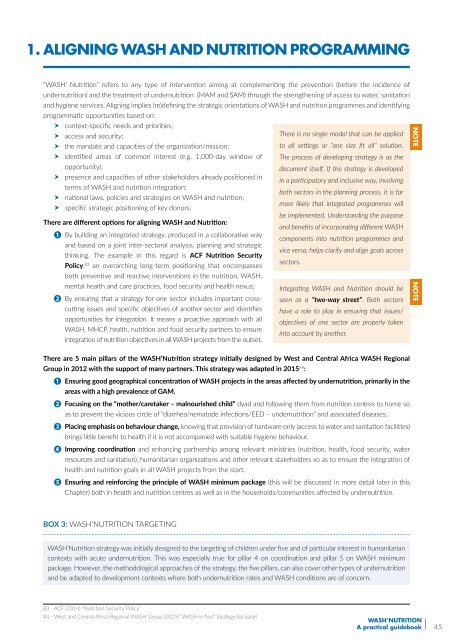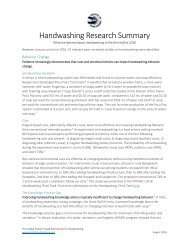WASH’ Nutrition
manuel_wash_nutrition_online
manuel_wash_nutrition_online
Create successful ePaper yourself
Turn your PDF publications into a flip-book with our unique Google optimized e-Paper software.
1. Aligning WASH and <strong>Nutrition</strong> programming<br />
“<strong>WASH’</strong> <strong>Nutrition</strong>” refers to any type of intervention aiming at complementing the prevention (before the incidence of<br />
undernutrition) and the treatment of undernutrition (MAM and SAM) through the strengthening of access to water, sanitation<br />
and hygiene services. Aligning implies (re)defining the strategic orientations of WASH and nutrition programmes and identifying<br />
programmatic opportunities based on:<br />
context-specific needs and priorities;<br />
access and security;<br />
There is no single model that can be applied<br />
the mandate and capacities of the organization/mission;<br />
to all settings or “one size fit all” solution.<br />
identified areas of common interest (e.g. 1,000-day window of The process of developing strategy is as the<br />
opportunity);<br />
document itself. If the strategy is developed<br />
presence and capacities of other stakeholders already positioned in<br />
in a participatory and inclusive way, involving<br />
terms of WASH and nutrition integration;<br />
both sectors in the planning process, it is far<br />
national laws, policies and strategies on WASH and nutrition;<br />
more likely that integrated programmes will<br />
specific strategic positioning of key donors.<br />
be implemented. Understanding the purpose<br />
There are different options for aligning WASH and <strong>Nutrition</strong>:<br />
and benefits of incorporating different WASH<br />
1 By building an integrated strategy, produced in a collaborative way<br />
components into nutrition programmes and<br />
and based on a joint inter-sectoral analysis, planning and strategic<br />
vice versa, helps clarify and align goals across<br />
thinking. The example in this regard is ACF <strong>Nutrition</strong> Security<br />
sectors.<br />
Policy, 83 an overarching long-term positioning that encompasses<br />
both preventive and reactive interventions in the nutrition, WASH,<br />
mental health and care practices, food security and health nexus; Integrating WASH and <strong>Nutrition</strong> should be<br />
2 By ensuring that a strategy for one sector includes important crosscutting<br />
issues and specific objectives of another sector and identifies have a role to play in ensuring that issues/<br />
seen as a “two-way street”. Both sectors<br />
opportunities for integration. It means a proactive approach with all<br />
objectives of one sector are properly taken<br />
WASH, MHCP, health, nutrition and food security partners to ensure<br />
into account by another.<br />
integration of nutrition objectives in all WASH projects from the outset.<br />
NOTE<br />
NOTE<br />
There are 5 main pillars of the <strong>WASH’</strong><strong>Nutrition</strong> strategy initially designed by West and Central Africa WASH Regional<br />
Group in 2012 with the support of many partners. This strategy was adapted in 2015 84 :<br />
1 Ensuring good geographical concentration of WASH projects in the areas affected by undernutrition, primarily in the<br />
areas with a high prevalence of GAM.<br />
2 Focusing on the “mother/caretaker – malnourished child” dyad and following them from nutrition centres to home so<br />
as to prevent the vicious circle of “diarrhea/nematode infections/EED – undernutrition” and associated diseases.<br />
3 Placing emphasis on behaviour change, knowing that provision of hardware only (access to water and sanitation facilities)<br />
brings little benefit to health if it is not accompanied with suitable hygiene behaviour.<br />
4 Improving coordination and enhancing partnership among relevant ministries (nutrition, health, food security, water<br />
resources and sanitation), humanitarian organizations and other relevant stakeholders so as to ensure the integration of<br />
health and nutrition goals in all WASH projects from the start.<br />
5 Ensuring and reinforcing the principle of WASH minimum package (this will be discussed in more detail later in this<br />
Chapter) both in health and nutrition centres as well as in the households/communities affected by undernutrition.<br />
BOX 3: <strong>WASH’</strong><strong>Nutrition</strong> TARGETING<br />
<strong>WASH’</strong><strong>Nutrition</strong> strategy was initially designed to the targeting of children under five and of particular interest in humanitarian<br />
contexts with acute undernutrition. This was especially true for pillar 4 on coordination and pillar 5 on WASH minimum<br />
package. However, the methodological approaches of the strategy, the five pillars, can also cover other types of undernutrition<br />
and be adapted to development contexts where both undernutrition rates and WASH conditions are of concern.<br />
83 - ACF (2014) “<strong>Nutrition</strong> Security Policy”<br />
84 - West and Central Africa Regional WASH Group (2015) “WASH in Nut” Strategy for Sahel<br />
<strong>WASH’</strong><strong>Nutrition</strong><br />
A practical guidebook<br />
45



